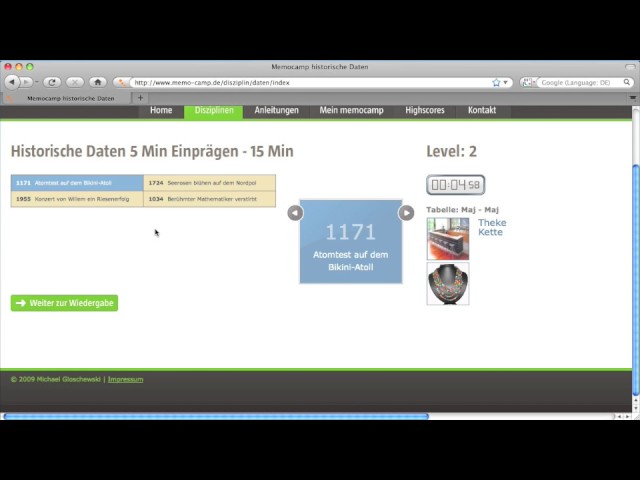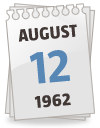
Um diesen Inhalt anzuzeigen muss eine Verbindung zu Youtube / Google hergestellt werden. Dabei werden von Ihrem Browser eventuell persönliche Daten übertragen und ausgewertet. Wollen Sie dennoch fortfahren?
How to remember dates and appointments - Memorise historical dates
There are plenty of historical dates or events. Everyone has its own important events in life which should be memorised, for example the wedding day, birthdays or business meetings. What is the best way to memorise these events?
We should distinguish between appointments, recurring events and fixed historical dates. If your friend Thomas has his birthday on 16th July, we remember "only" the combination of 16-7. We translate this combination and transform the numbers into bags and socks by using the sMajor-systems. Then we create a little story. As a result, you always offer to Thomas a bag of socks for his birthday.
My suggestion to remember business meetings consists of creating two calendar routes with 31 journey points respectively. The first route applies to the current month, the second route to the following month. At the end of the first month, the first route will be set apart and used as a "third" route. In this way, you will have enoguh time to delete the stored appointments from your memory. If you prefer planning less than a month ahead, a weekly plan could be sufficient for you. Here I would recommend converting images into weekdays.
| Weekday | Picture |
|---|---|
| Monday | Moon: By the way, the moon landing took place on July 21st, 1969 on a Monday. Try to calculate it by using the method of Calculating calendar dates! |
| Tuesday | Service: A group of craftsmen and service providers who are all doing their service. |
| Wednesday | Target: We always try to target the exact middle. |
| Thursday | Thunder: On Thursday, there will be a thunderstorm with lots of rain. |
| Friday | Free: Imagine lying in a hammock! In your free time, you will lie in your hammock. |
| Saturday | Collection: Imagine that you are looking at a large image collection. |
| Sunday | Sun - This is evident. |
Now you have to link the appointment with your journey point or with the image you used for the weekday. Here are two small examples: On the 17th of the month, you have to go to the dentist. Then you imagine the 17th journey point of your first monthly route, which represents, for example a bus stop. Then you have to link dentist with bus stop. On Wednesday you are planning to take a coffee with Franziska. Imagine that both of you try to target the coffee bean, which is located in the middle of the target, with bow and arrow.
Memorising historical dates
For most of the historical dates, it is only important to remember the year. Day and month are secondary. Whether we try to remember real events or fantasy events, the procedure is always the same. During training and at the championships we take fantasy dates to avoid that participants already learned "all" historical dates and "only" have to recall them. We try to remember the following dates:
| Year | Event |
|---|---|
| 1084 | Messenger raced round Napoleon |
| 1356 | Bull in a china shop |
| 1955 | First camel on the moon |
Usually, the events you have to memorise are funny events. For the memorisation procedure, it is important to know the Major-system. We split the number 1084 in two images: 10 stands for cup, 84 for fire. Now we create a little history, in which the event or the person occurs. In this case, it is Napoleon.
It is dark. Napoleon stands next to the campfire with a cup of tea to warm up. Suddenly, a messenger appears. He wants to deliver an important message. He runs so fast that he is not able to stop in time and he races round Napoleon.
To memorise the next event, we proceed in the same way: We split 1356 into two images, 13 stands for team, 56 stands for hole and we add the elephant. Try to imagine that the elephant could have entered the china shop through a hole in the wall and a team of football players tries to catch the elephant. Lots of porcelain is broken afterwards. For the third event, we have the following ingredients: 19 tepee, 55 lollipop and camel / moon. A camel lives on the moon. It is standing next to his tepee and is sucking on a lollipop.
Now it is quite easy to recall the number, right?
| Year | Event |
|---|---|
| _ _ _ _ | First camel on the moon |
| _ _ _ _ | Messenger raced round Napoleon |
| _ _ _ _ | Bull in a china shop |
This also works, of course, with real historical dates. Imagine a man puzzling together parts of a script. He is sitting in a bar at the bar. Then he goes home, lies down in his hammock and covers himself with an octopus. The next morning, he goes to church and attaches his manuscript. This is strange, isn't it? Yes, but now you know when Martin Luther nailed his 95 theses to the Castle Church of Wittenberg, namely on the 31 st(mat) October (octopus) 1517 (part, counter). That was a Wednesday, by the way.
How to train the memory for numbers: Historic Dates
In this discipline you have to memorise as many historical dates as possible. The dates are virtual dates. If we had not invented these dates, we all would have known them.
The time span of the dates lies between 1000-2099.
The evaluation is based on championship rules meaning if a date is not correctly recalled, 0.5 points will be taken away. Example: If you have recalled 10 dates and 7 are correct, 3 are not correct. This is equal to 5.5 championship points.
It is not possible to have negative points at the end.
Here is an example:
1425 First sheep on the moon
1827 Loss of savings bank book
Recall:
_ _ _ _ Loss of savings bank book
_ _ _ _ First sheep on the moon
 Menü
Menü
